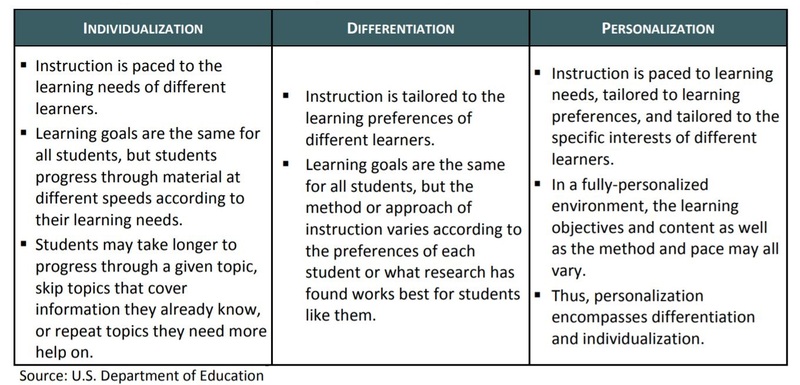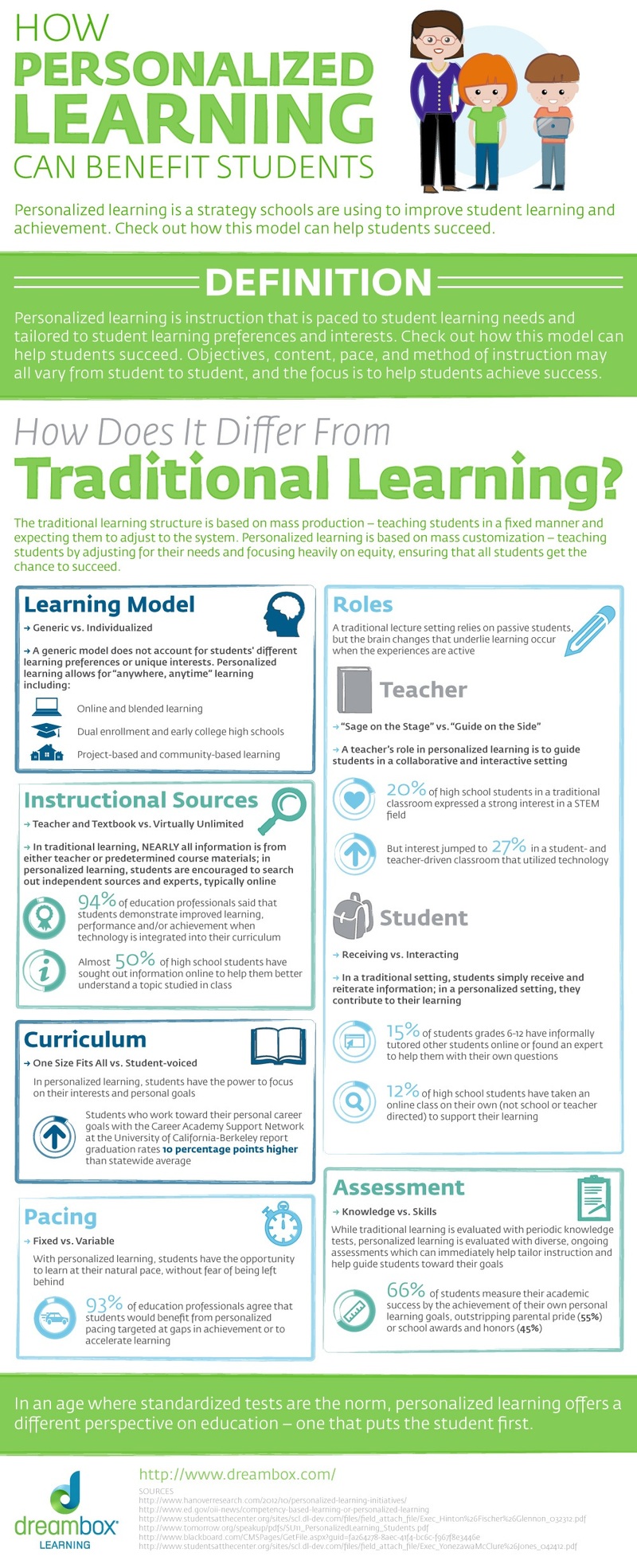e-Learning Ecologies MOOC’s Updates
Personalized Learning: One-Size Doesn't Fit All in The Classroom
Personalized learning is an educational approach that delivers individual lesson plans for each student based on their learning style, interests, strengths, and needs. It encourages students and educators to work closely together to develop a learning plan that both challenges and engages the individual student (Url-1). It is not a one-size-fits-all approach.
The U.S. Department of Education distinguishes between individualization, differentiation, and personalization of instruction since some educators use the terms interchangeably. Personalized instruction encompasses aspects of both differentiated instruction, which refers to adjusting the learning approach, and individualized instruction, which refers to adjusting the pace of learning. Table 1. illustrates the distinguishing features of individualized, differentiated, and personalized instruction (Hanover Research, 2014).
Personalized learning takes a different approach from the typical one-size-fits-all classroom model that teaches a standard curriculum to all students, with little differentiation. Instead, it tailors personal learning plans to the individual knowledge, skills, interests and learning styles of each student (Powell, 2019).
The purpose of personalized learning is to open student pathways and encourage student voice and choice in their education. Differentiation is a key part of personalized learning, and it is essential in education. In personalized learning environments, educators seek to meet each student within their own zone of proximal development. Without personalization, there is a gap between the individual student, their learning, and the support they need to succeed in a way that makes sense to his/her interests (Slocum, 2016).
Here are 5 benefits that come with personalized learning model (Sutty, 2018):
1. Student-Centered Classrooms
- Learning activities are meaningful and connect to student interests
- Authentic learning empowers students
2. Active Learning Environment
- Instruction utilizes a variety of learning styles that support every learner
- Personal attention is given to ensure that every child develops their intellectual and creative talents
3. Collaborative and Cooperative
- Students work with others to explore ideas and use knowledge for meaningful tasks
- Teachers are facilitators of learning to guide them in acquiring knowledge
- Opportunities are provided for students to become “creators of content”
4. Creates Positive Attitudes for Learning
- Enthusiasm for school is increased
- Creates life-long learners
5. Caring and Supportive Learning Environment
- Student-teacher relationships are respectful
- Parents partner with teachers to encourage student achievement
According to the Organization for Economic Cooperation & Development (2006), there are five phases of personalized learning (Patrick, 2015):
- Assessment: Teacher and students work together in a formative manner to identify strengths and weaknesses.
- Teaching and learning: Teachers and students select learning strategies.
- Curriculum choice: Student chooses the curriculum, creating a pathway for student choice.
- Radical departure from typical education models: Built on student progress, this phase provides teachers the flexibility to choose their own teaching strategies.
- Education beyond the classroom: Using social and community connections, students personalize their surroundings (with the help of the teacher, when needed) to create their ideal learning environment.
Here are five strategies educators can do to contribute to a personalized learning experience that sets students up for long-term success (Url-2).
- The problem-based approach starts with a problem framed by the teacher to align with specific standards. Students have the autonomy to pursue a problem in any way that they find beneficial. They are allowed to struggle, which will help to increase their cognitive processing skills.
- The point-based approach is one of my personal favorites; it allows students not only personalize to their class period for a single day but to plan their entire week. Students are presented with a menu of options that includes specific assignments, projects, or deliverables that they can mix and match as they choose.
- The students-as-teachers approach elevates students’ role by asking them to teach a lesson, pushing them to dig deeper into content, often looking at the theory behind it in order to explain concepts, answer key questions, and address misconceptions.
- The project-based approach allows students to be creative and work through the entire scope of creating and implementing a project. For example, a student passionate about theater could write a one-act play related to key learning goals, making the work more interesting and aligned to students’ passions.
- The standards-based approach is popular and a great place to start with self-directed learning: here, students work at their own pace while demonstrating mastery of the standards, allowing quick acceleration in some cases, and more support where it’s needed.
Examples:
- What does personalized learning in action look like in the classroom?
As noted in this video of an AASA collaborative site visit to Fremont School District 79, the goal isn’t simply one big open space or a small space. It’s the idea that form follows function, and form leads function
- What Does A Personalized Learning Science Unit Look Like?
Science teacher David Russo from Madison Public Schools, Conn. is part of an innovation project to experiment with personalized learning throughout the year with Allison Zmuda.
Below is an excerpt from what Russo call the “Unit Syllabus” for the first unit. The students get one of these at the beginning of every unit. It acts as a roadmap for them to navigate the assignments, activities, and expectations of the unit. As you will see it contains an essential question followed by a number of assignments and activities designed to facilitate the gathering of necessary information that will ultimately be used to answer the essential question.
https://www.learningpersonalized.com/personalized-learning-science-unit-look-like/
For further evidence regarding the benefits of personal learning, have a look at the infographic below created by dreambox learning (Ferriman, 2020). The infographic, How Personalized Learning Can Benefit Students, shows how the personalized learning model boosts engagement, achievement, and helps both students and teachers optimize their educational efforts for greater success (DreamBox Learning, 2013).
Videos about Personalized Learning:
References:
DreamBox_Learning. (2013), “How Personalized Learning Can Benefit Students”. Retrieved on August 1, 2021 https://www.learndash.com/wp-content/uploads/How-Personalized-Learning-Can-Benefit-Students-Infographic.jpg
Ferriman, J. (2020), “The Benefits of Personalized Learning”. Retrieved on July 31, 2021 https://www.learndash.com/the-benefits-of-personalized-learning/
Hanover Research. (2014), “Best Practices in Personalized Learning Implementation”, District Administration Practice. Retrieved on July 31, 2021 https://www.hanoverresearch.com/media/Best-Practices-in-Personalized-Learning-Implementation.pdf
Patrick, S. (2015), “Education Transformation: From One-Size-Fits-All to Student-Centered Learning – Part One”, Issue(s): State Policy, Issues in Practice, Rethink Instruction. Retrieved on July 31,, 2021 https://aurora-institute.org/blog/education-transformation-from-one-size-fits-all-to-student-centered-learning-part-one/
Powell, P. (2019), “What Is Personalized Learning? A Complete Guide to Individualized Education in the Classroom”. Retrieved on July 31, 2021 https://xello.world/en/blog/personalized-learning/
Slocum, N. (2016), “What is Personalized Learning?”, Issues in Practice, How to Get Started.Retrieved on July 31, 2021 https://aurora-institute.org/blog/what-is-personalized-learning/
Sutty, S. (2018), “Five Advantages of Personalized Learning”, Education Matters—Sanford School's Private School Blog. Retrieved on July 31, 2021 http://blogs.sanfordschool.org/five-advantages-of-personalized-learning
Url-1. “How to Incorporate Digital Personalized Learning in the Classroom: The Complete Guide to 21st Century Learning”, xello. Retrieved on July 31, 2021 https://xello.world/en/incorporating-digital-personalized-learning-in-the-classroom/
Url-2.” 5 Strategies for Personalized Learning” Retrieved on July 31, 2021 https://edalliesmn.org/wp-content/uploads/2019/10/EdFellows-5-Strategies-FINAL.pdf
Additional Resources:
Six Examples of What Personalized Learning Looks Like
This is what personalized learning looks like
From One-Size-Fits-All to Personalized Learner-Centered Learning: The Evidence
How to implement personalized learning in the classroom
7 Personalized Learning Strategies To Implement In Class & Examples
Videos:
Reimagining Classrooms: Teachers as Learners and Students as Leaders: https://www.youtube.com/watch?v=w6vVXmwYvgs
Revolutionizing Education with Personalized Learning: https://www.youtube.com/watch?v=hC-zBsc1w-c
A vision for radically personalized learning: https://www.youtube.com/watch?v=y9ZX9ApLLh0
Flexible Classrooms: Making Space for Personalized Learning: https://www.youtube.com/watch?v=jQkL5efkViw



